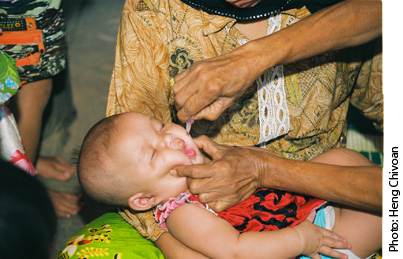Using data to unlock the power of vaccines for child health
|

There are a number of seemingly insurmountable development challenges, but child survival — particularly combating diarrheal diseases — is not one of them.
The Global Enteric Multicenter Study (GEMS), published in The Lancet last week, provides health and policy experts with evidence to pinpoint areas where research for new vaccine candidates is urgently needed to combat diarrheal diseases — the second leading cause of death among children globally. It also reveals other important opportunities for intervention.
GEMS, coordinated by the University of Maryland School of Medicine's Center for Vaccine Development, filled critical gaps in knowledge that were not captured in previous studies by using consistent methodologies across seven of the highest-burden countries and enrolling more than 20,000 children over the course of three years.
The study tested for almost 40 pathogens and confirmed that just four are responsible for the majority of moderate-to-severe diarrhea cases: rotavirus, Cryptosporidium, Shigella and ST-ETEC, a type of E. coli.
We can make cross cutting inroads in reducing the transmission of these pathogens by expanding access to treated water supplies and improving sanitation. Complications and mortality among children who develop diarrheal disease can be reduced by providing oral rehydration and zinc therapy. However, we can also decrease the susceptibility of young children to these infections by providing vaccines that make them immune to these specific pathogens. Indeed, vaccines are among the most cost-effective specific tools that we have to prevent clinical illness as well as to interrupt the spread of infectious diseases.
Fortunately, we already have two licensed vaccines that protect against rotavirus, the leading pathogen identified by GEMS, and a third seems to be well on its way toward approval. The GAVI Alliance's efforts to rollout these vaccines in high burden countries will have a dramatic effect on improving child health. We commend the commitments of manufacturers to improve access to these vaccines by making them available to infants in the world's poorest countries at lowered prices in conjunction with GAVI. Further refinements to these vaccines, such as making them heat stable, will help achieve an even greater impact.
In addition to rotavirus, it is critical to rally support for the development of vaccine candidates for the other three leading causes identified by GEMS.
Shigella and ST-ETEC were previously estimated to account for nearly one billion cases of diarrhea annually; as a result, approximately 300,000 children die each year before they reach their fifth birthday. GEMS confirmed these two pathogens as leading causes and added a renewed sense of urgency to the need to accelerate the development of vaccine candidates. These bacteria have been on the radar of some scientists and vaccine developers and have been priorities of the World Health Organization. Nevertheless, additional support is needed to bring these products to market faster and save more lives.
Cryptosporidium, the second most common cause of diarrhea among young children across all study sites, was not considered to be a major cause of diarrheal disease prior to GEMS. Unfortunately, little research is underway for a vaccine and only one drug is approved for treatment, but it is limited to use in children who are HIV negative and above one year of age. It is imperative that we expedite the research needed to develop a viable vaccine candidate.
Developing and delivering vaccines for these top diarrheal disease pathogens will require stakeholders at all levels to advocate for the resources needed to create inexpensive, simple tools that can be implemented in low resource settings across sub-Saharan Africa and South Asia where the need is greatest. Advocates will also need to push for policy changes in these regions to expedite regulatory approvals and rollout of new vaccines.
As health and policy experts debate the prioritization of investments for global health, they must remember that vaccines are one of the most powerful and cost-effective tools available to improve child health and advance our broader development goals. Now that we are able to better quantify and measure the burden of diarrheal disease, we can assess the impact of evidence-based decisions aimed at improving child health.
It's time to replace rhetoric with action for every parent or caregiver who wants nothing more than to look their child in the eye and know with certitude that they can provide for their health needs. We owe it to the world's children to provide them with access to every effective tool to survive the gauntlet of potentially lethal infections they confront during early childhood while living in the world's least developed countries.
For more information:
-- INFOGRAPHIC: The GEMS data visualized
-- NEWS: Results of Phase III rotavirus vaccine candidate show promise
-- PHOTOS: Vaccines are foundational to child health














